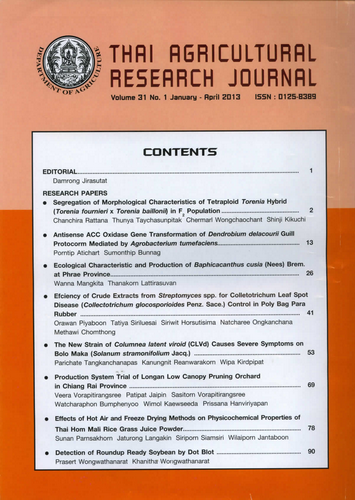The New Strain of Columnea latent viroid (CLVd) Causes Severe Symptoms on Bolo Maka (Solanum stramonifolium Jacq.)
DOI:
https://doi.org/10.14456/thaidoa-agres.2013.23Keywords:
Columnea latent viroid (CLVd), severe strain, Solanum stramonifolium, pathogenic domainAbstract
Columnea latent viroid (CLVd), one of the smallest plant pathogens consisting of 367-374 nucleotides, is an important plant pathogen in tomato causing stunting, necrosis of leaf veins, petioles, and stem, leaf discoloration, flower dropping, small fruits, as well as death of the whole plant, Nevertheless, it can cause high yield loss in tomato, potato, and pepper crop productions, but cut causes symptomless on some species of Solanum such as eggplant (Solanum melongena), and bolo maka (Solanum stramonifolium). ln 2011, a new strain of CLVd was found inducing severe symptoms in bolo maka such as stunting, apical stunt, rugosity and mosaic of leaves, small lateral leaves, necrosis of leaf veins and petioles, By nucleotide sequence analysis of the new strain and the previously reported CLVds in GenBank, 7-9 different changed gases were shown In these bases, only two bases at position 83 and 292 that varied by the symptom on bolo maka. Both positions were part of pathogenic domain (P domain) on the new strain which base A was added at the position 83 (base insertion) and A or T was changed to G (base substitution) at the position 292. Since, the pathogenic domain sequences (nucleotide position 39-91 at upper P-domain and 277-328 at lower P-domain) have been known as the domain that controls the disease symptoms and virulence on host plants of most viroids. Base on this work, it is possible to assess whether the two positions play the role in the pathogenicity and severity controller of this viroid. This is the first report for CLVd. However, to prove this hypothesis, further study is needed to confirm the assumption.
Downloads
Published
How to Cite
Issue
Section
License
Copyright (c) 2017 วารสารวิชาการเกษตร (Thai Agricultural Research Journal)

This work is licensed under a Creative Commons Attribution-NonCommercial-NoDerivatives 4.0 International License.
Thai Agricultural Research Journal



